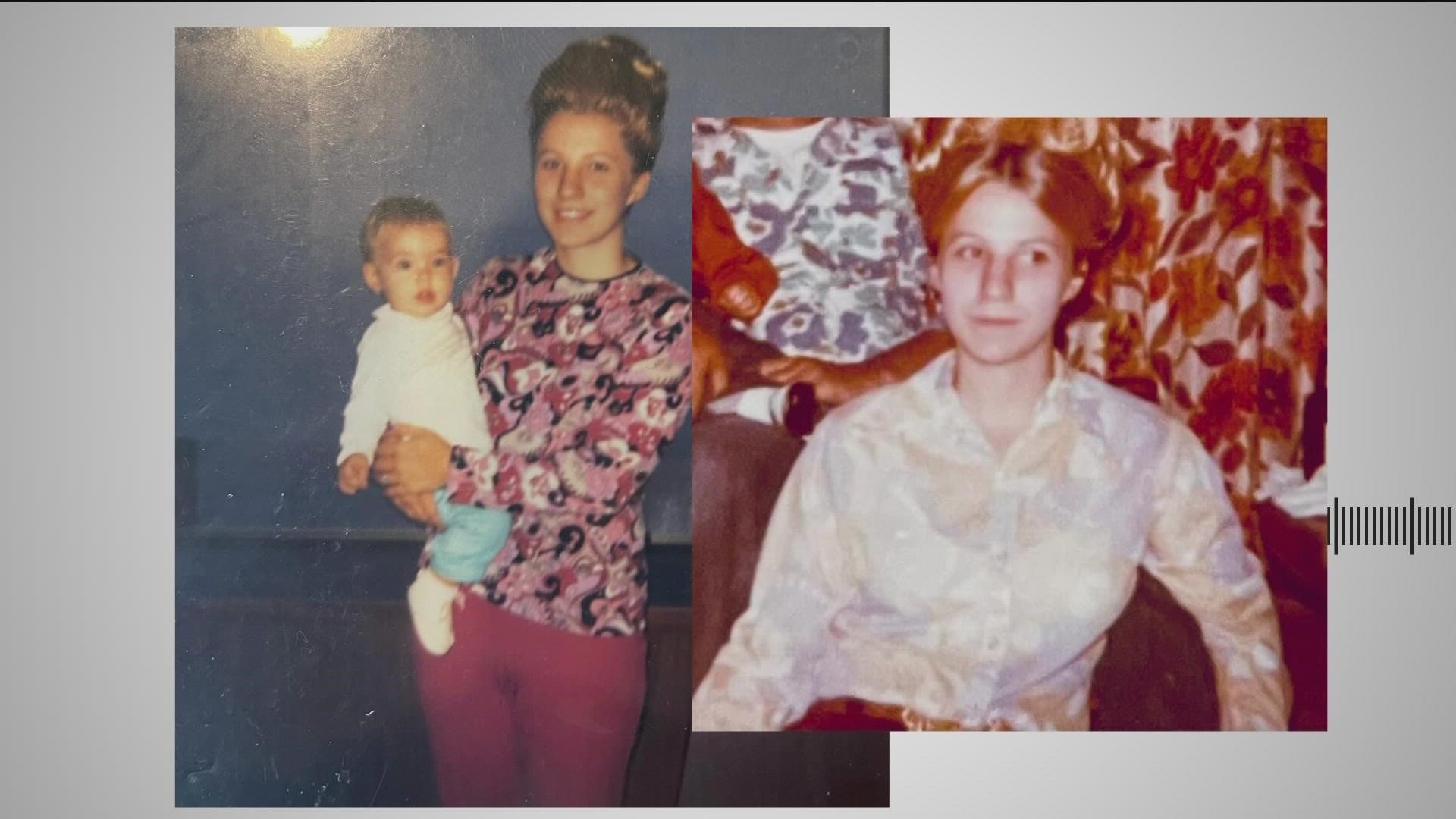LEWISTON, Idaho — Suzanne Timms was heartbroken when she found out Oregon State Police discovered zero additional evidence from their excavation of a gravesite in mid-August, belonging to an unidentified woman found in 1978. Timms desperately needs more evidence to prove that this woman, known as the “Finley Creek Jane Doe,” is her mother – who went missing from Lewiston on Aug. 31, 1976.
Timms is 48, living in Walla Walla, Washington, with her family. Her office at home is dedicated to her mother and grandmother, their pictures taped up around her. She speaks to her mother often, wherever she may be.
There are too many similarities between Doe and Timms’ missing mother, Patricia ‘Patty’ Lee Otto, Timms said. She has been fighting tirelessly for answers since she was 18 – just last year, she came across a composite image of a Jane Doe on a Facebook page that looked exactly like her mom. Timms discovered the photo was an artist rendering of a deceased woman that matched her mother’s description almost exactly.


Not only that, but Timms’ father-in-law and her grandfather-in-law were the hunters that first discovered the remains 44 years ago. She had no idea she married into that family until she began researching — and she believes this was her mother’s way of guiding her to the right answers.
Just last week, Timms brought her findings to the Lewiston Police Department. Timms said they were in shock with how much research she had done into the two cases.
To her disappointment, however, the case into the Finley Creek Jane Doe was closed in 1990 “due to age” according to a police report. The unidentified woman was cremated, with no additional evidence collected from the skeletal remains.
As of now, Timms has nothing from the woman to compare Otto’s DNA to.
She was filled with hope when OSP said they would go to the gravesite to excavate it after the Finley Creek Jane Doe Task Force, a volunteer group, brought out cadaver dogs that hit on multiple areas in the forest.
But, after two days of searching and sifting through dirt, the OSP forensic team found only animal bones. Timms sat through a work meeting, her eyes welling up with tears, after she found out the news through a Facebook post.
“I really thought they’d find something,” she said.
As Timms stood in the area of the excavated gravesite, seeing for the first time what OSP did to try and find more bones, she said she felt overwhelmed because it’s so disheartening to know after all this time there were no additional remains in the gravesite.
“I can’t identify her without one shred of DNA.”
The disappearance of Patty Lee Otto
Patty Lee Otto was born on Aug. 4, 1952. She was a great student and an avid church-goer, according to her daughter. She grew up in Lewiston, where she later met her husband, 34-year-old Ralph Otto, at the age of 16. Ralph Otto was working for the forestry service. The two became close when Patty Otto was working, cleaning and babysitting for his friends. They were married on Oct. 17, 1970, and Patty Otto later had two children – Suzanne, at the age of 21, and Natalie, at the age of 19.
“He groomed her,” Timms said. “She took someone else to prom, because how weird is it to take your 34-year-old boyfriend to prom?”
Patty Otto decided to file for divorce and leave her husband at some point in their marriage – she got her own apartment and took her two children with her. She was working at an insurance company, but began attending Valley Business School in town taking evening courses. She would work, take care of her children, then drop them off at her parents’ house to attend her classes.
During the spring of 1976, Patty Otto developed an intimate relationship with an old childhood friend of hers who returned from the military. However, Ralph Otto convinced her to come back, and the two reconciled. Their relationship was full of ups and downs, Timms said.


Otto was 24 years old when she was last seen by her family on Aug. 31, 1976 in her hometown of Lewiston. She was wearing red knit pants and a white shell top, possibly with cherries on the front. She was 5-feet 3-inches tall and had dirty blonde hair.
The night her mother went missing, Timms said she and her sister were picked up from their grandparents’ house around 11 p.m. after their mother finished her classes. Later that night, Timms remembers hearing yelling upstairs.
As she slowly crept up the stairway, she watched as an argument between her mother and father unfolded, peering into the living room through white railings next to the staircase -- she said her mother hit her father, and he hit her back. That’s when he went for his wife's neck, Timms said.
“He wrapped his hands around her throat and pushed her up against the wall. I immediately knew this was not good. I didn't know what was happening. But, I was frightened. As he was pushing her and dragging her away, I ran back downstairs,” she said. “I was crying and told my sister I was scared because I didn't know what was happening, but I knew it was bad. She was comforting me telling me that it was going to be okay. She didn't go back upstairs. She didn't go check.”


Timms was only three years old, and her sister was just five at the time. The memory was so disturbing, she said, that it is burned into her brain even as a young child.
“When you see an impactful moment, your brain tends to play it over and over again,” Timms said.
The next morning, Sept. 1, Patty Otto was nowhere to be found. Ralph Otto scooped up the kids and drove them across the river to Asotin, Washington, to help his friend known as ‘Bonnie’ move to California.
“(Ralph Otto) was yelling at us to get our shoes, we had to go. So when we leave, we are in the car driving across the river, and our dad is telling us that our mom doesn’t want to be a mother anymore and she’s not going to come home,” Timms said.
Timms opened Patty Otto’s scrapbook and pointed to the numerous pictures of their family together. Baby pictures, pictures of her children with Santa Clause and other memorable moments filled the thick pages, all scribbled with Patty Otto’s handwriting.
“Does this look like a book of a woman that hates her kids and doesn’t want to be a mom?” Timms asked.
Ralph Otto brought the children to Patty Otto’s sister’s home two days later, where he said he was going to go look for his wife, which was a red flag – Patty Otto never left her children alone with her husband, Timms said. She would always find a babysitter or a family member to watch them.
Patty Otto’s family gave her the evening to come back. When she didn’t, her parents reported her missing to the Lewiston Police Department the next day – Sept. 2.


Ralph Otto told police had been drunk when his wife came home with the children that night, which he claimed was Sept. 2, not Aug. 31. The report, from officer T. Saleen, says that “Ralph heard a horn honk out front” and that Patty Otto went outside, taking her purse with her, and he had not seen her since. He assumed she had run off with her former boyfriend, Randy Benton.
Police searched the property after speaking with Ralph Otto on the morning of Sept. 5, 1976, and wrote in the report they “did not find any sign whatsoever of foul play” and advised Ralph Otto to “get off the drugs and whiskey” so “his wife would return to him.”
“They thought it was a marital spat, so they assumed she would come back home. It wasn’t pursued as a homicide,” Timms said. “My father did not let the police talk to my sister and I.”
Fifteen years went by, and all the while, Timms believed what her father had told her – that Patty Otto did not want to be a mother anymore.
“When we turned 18 we got the police file,” Timms said. “It was very apparent my father was responsible just by reading the reports.”
The reports corroborated Timms’ story — a close friend told detectives that on Dec. 4 that year, Timms told him, as a three-year-old, that “Mamma hit daddy, daddy hit mamma, daddy carried her out.”

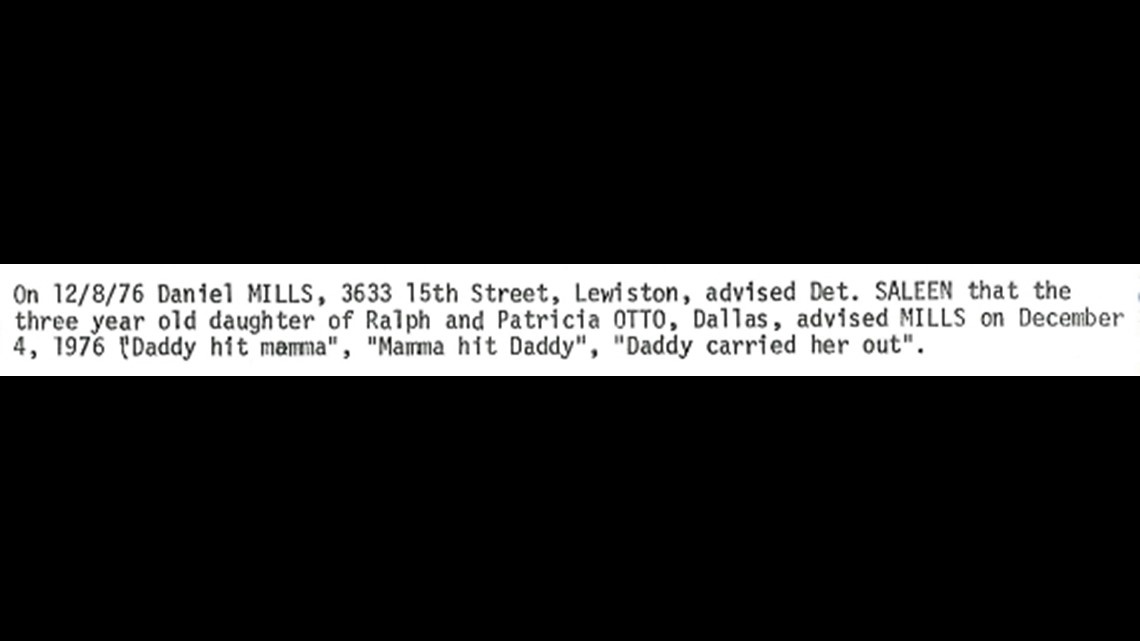
Witnesses who arrived at the Otto residence in the days after her disappearance told police they observed a tarp and a shovel, as well as a cushion missing off one of the sofas.
The police reports also specify that on Sept. 4, 1976, her wedding rings were found in her husband’s coat pocket, hanging in Ralph Otto’s bedroom.
During the investigation, a woman named Verna Eddy sent detectives a letter saying Ralph Otto had choked and raped her, while “laughing like a mad man.”
Other women, like Ralph Otto’s former wife, told detectives the two had many fights in their marriage and that she was “slapped around,” police reports say.
Shirley Tuschoff, a friend of Ralph Otto, indicated to police that he “stabbed Patty when she had come at him with a gun. Tuschoff further advised that Ralph made the statement that he was surprised the kids had not ratted him.”
He later told police that his wife was a “very jealous person” due to the friends he associated with, reports say, and that she was “greedy” because he made good money working in the forest clearing land in North Idaho. Meanwhile, police discovered Ralph Otto was having an affair the year his wife disappeared, with an old flame of his.
The previous girlfriend wrote in her diary she had “gone five rounds” with someone named “R” who police believed was Ralph Otto, and claimed she had loved him for almost 11 years. Police wrote in the supplemental report that a witness said it seemed odd Patty “came up missing” right after this woman had attempted to murder her husband.
“I have their love letters from when he was in prison,” Timms said.
Ralph Otto later died in police custody on Sept. 8, seven years after Patty Otto went missing, when he was booked in the Clearwater County Jail for theft, according to South Idaho Press archives.
Ralph Otto also served four years in prison for attempted murder, but the Idaho Supreme Court overturned his sentence.
He allegedly gave $250 to an Idaho Liquor Law enforcement officer to kill Captain Duane Ailor of the Lewiston Police Department. Once Ailor was dead, he promised the person $750, the archives said. According to Timms, he gave the captain somewhat incriminating information about his wife’s disappearance, and that could be why he decided to take a hit out on the officer.
If Timms’ father, Ralph Otto, knew anything about where his wife was — it died with him.
The Finley Creek Jane Doe
On Aug. 27, 1978, hunters in the Oregon forest stumbled across human remains near Finley Creek, 18 miles North of La Grande. The hunters told police they could see a human head and partial rib bones in a shallow grave located on a hillside.
According to police reports, at 3:30 p.m., officers at the La Grande patrol office were contacted along with Union County Assistant Deputy Medical Examiner Donald Rose, and State Medical Examiner William Brady. Eric Valentine, the Union County District Attorney, was called and advised about the remains, and teletypes were sent to Salem and Baker City police headquarters.
The next day, Sgt. John Spilker pulled up to the scene at 8:05 a.m., police reports say.
The gravesite of the remains resides on a tree-covered hillside present-day, but 44 years ago, the hillside was covered with ferns and brush.
Investigators found a human head with a spinal column, along with rib bones, the left pelvis bone, pieces of white cloth with what looked like red hearts printed upon the fabric, a nylon cord and a zipper.
The grave was 29 inches deep, 20 inches wide and four feet long, the report said.
While searching, police also found light blonde or brown hairs, other parts of the pelvis, arms, legs, as well as a white halter top, red knit pants size 15/16 that looked to be altered, and ankle-high shoes – along with a radio antenna wire, two feet long and tied in a knot. Near the pelvic bones, small bones were also found, which told police the person could have been pregnant and the smaller remains belonged to a fetus.
Later, examiners came to the conclusion the remains belonged to a white woman with light brown or blonde hair, estimated to be between 5-feet and 5-feet 4-inches tall, in her early twenties, with extensive dental work and a nearly full-term fetus.

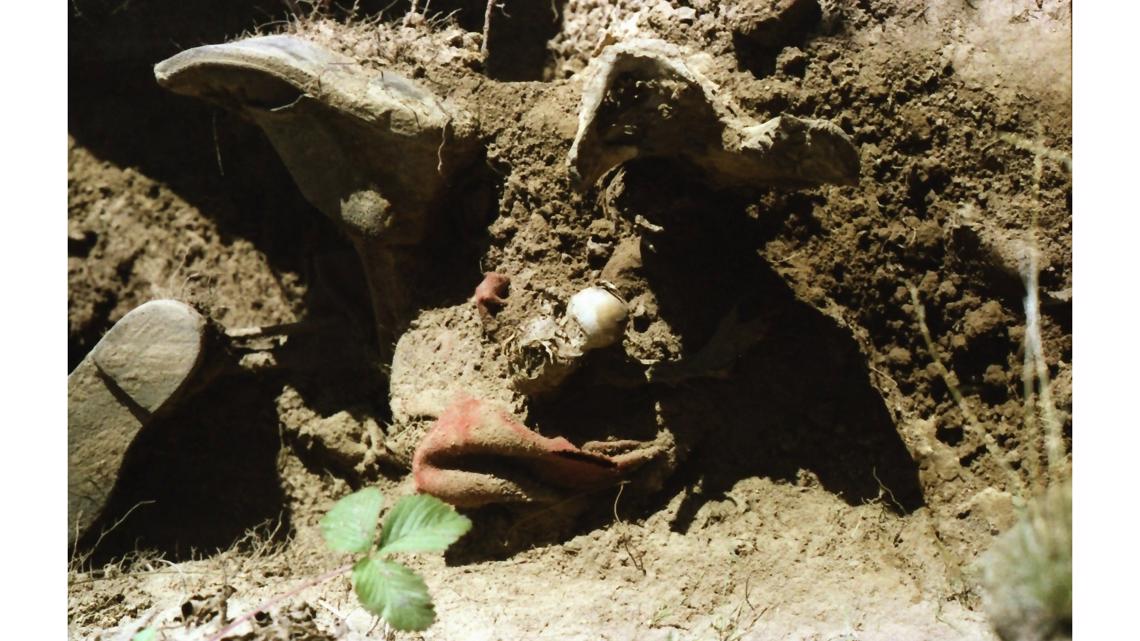
They estimated she had been dead for two to five years at the time of discovery. Her death was ruled undetermined.

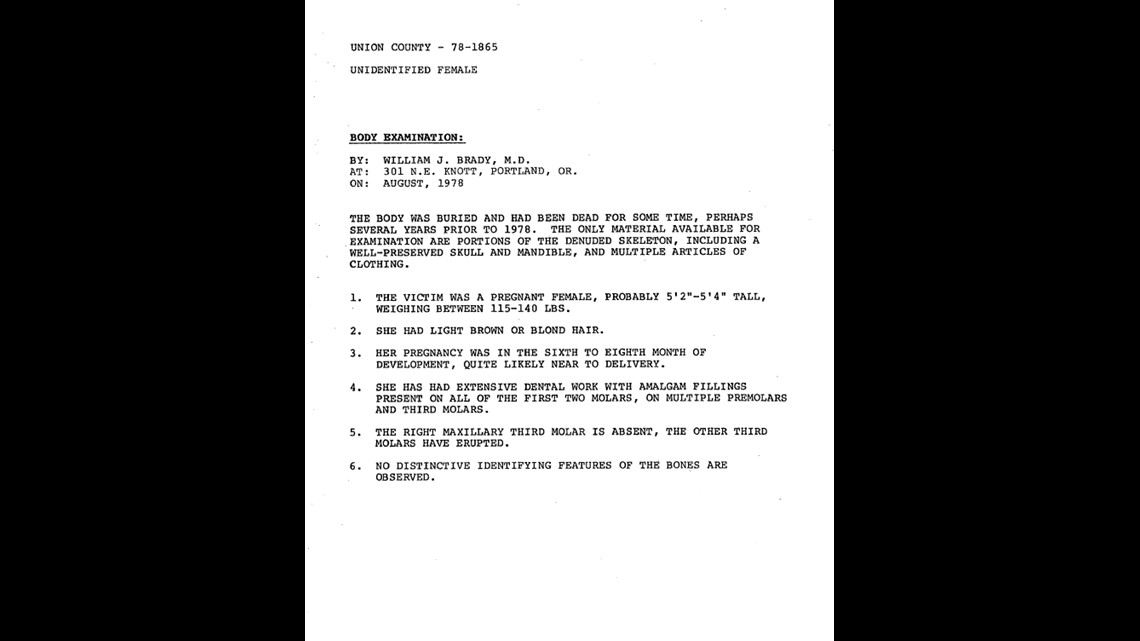
For months, police agencies all over the northwest contacted the Oregon State Police to present cases of young missing women that matched the description of the Jane Doe found near La Grande. Each one was slowly ruled out by the medical examiner through dental records.
On Sept. 11, 1978, State Medical Examiner William Brady sent a report to the lead sergeant on the La Grande Jane Doe – where he claimed to have compared missing Lewiston woman Patty Otto’s dental records.
Brady came to the conclusion that because he saw a note that Patty Otto’s wisdom teeth may have been removed, “The skull is clearly not that of Patricia Otto,” he wrote.
The notion that Patty Otto’s wisdom teeth were all removed only came from a handwritten note on the envelope of her x-ray, implying she was likely to have one or all of her teeth removed — so somehow, investigators and examiners came to the conclusion that all of her wisdom teeth were gone. Timms confirmed this note was written by a friend of Patty Otto’s, who went to the dentist with her to get copies of the x-rays — not an actual dentist.

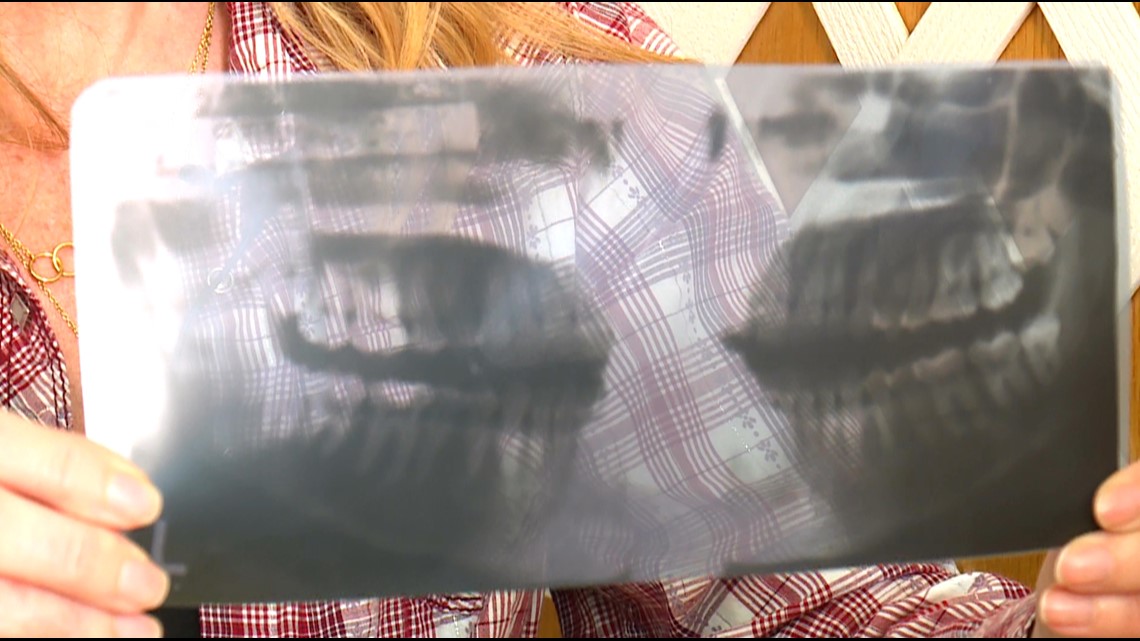
Timms also says this medical examiner mismatched the records to begin with.
The report from the medical examiner shows Brady replied to an inquiry from the police about matching Jane Doe’s dental records to Patty Otto – but the inquiry was about a Jane Doe found in Portland on Aug. 10, not the Finley Creek Jane Doe found Aug. 27.
KTVB reached out to OSP, but said they have “nothing to provide” about the alleged mismatching of the records.
Years went by with no identification of the woman found in the Oregon forest.
On June 28, 1990, OSP and the district attorney ordered the remains to be cremated and the evidence to be destroyed due to the “age” of the case, even though DNA testing was in its infancy.

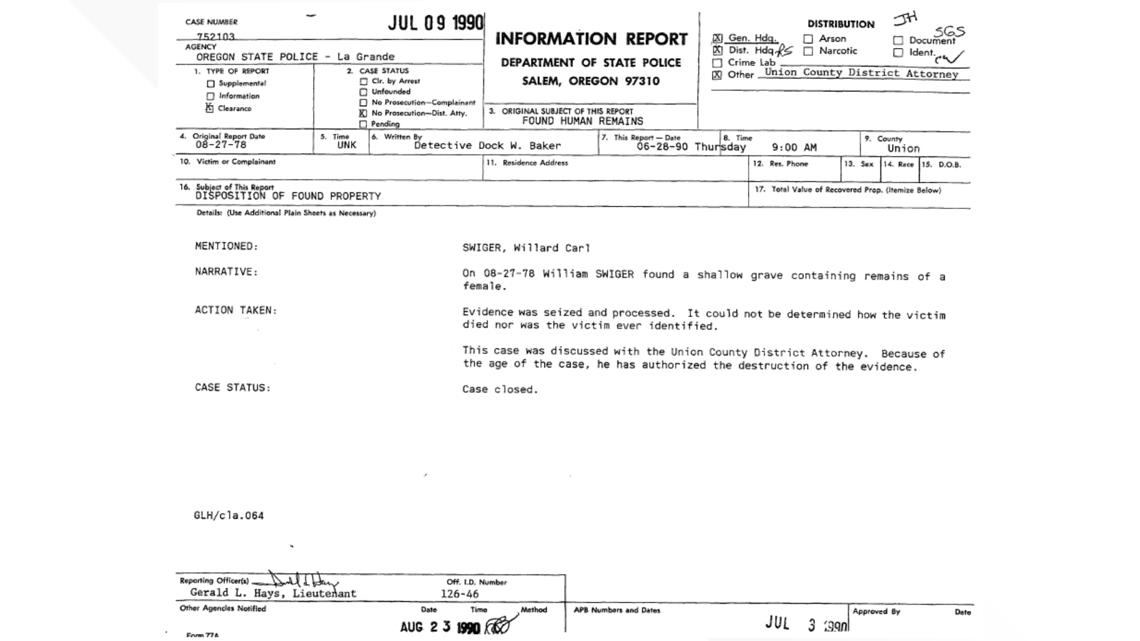
“It could not be determined how the victim died nor was the victim identified,” the report said. “Case closed.”
A possible connection
In June of 2021, Timms was browsing the internet, when she was suddenly stopped in her tracks – a sketch of a blonde woman known as the “Finley Creek Jane Doe” posted on a Facebook page looked exactly like her.


The page, The Finley Creek Jane Doe Task Force, looked to be utterly dedicated to finding out the identity of the woman who was found outside of La Grande in 1978. Timms stomach turned, as she put two and two together — could the woman found in Oregon be her missing mother?
Timms reached out to the task force, where they told her they had been doing extensive work with Redgrave Research Forensic Services to create an accurate composite of the unidentified woman as well as sending cadaver dogs to the gravesite to sniff out more remains they could snag DNA from.
Through hundreds of papers and police filings, the task force began to believe that their Jane Doe was Patty Otto.
Melinda Jederberg, a founder of the task force, told KTVB that their task force first got the Finley Creek Jane Doe out on the airwaves through podcasts and social media. She believes the woman is Timms’ missing mother as well.
The similarities between the two are nearly impossible to ignore.
- Patty was last seen wearing red knit pants and a white shirt. Jane Doe was found wearing red knit pants and a white shirt.
- Jane Doe's white shirt was reported to have "red hearts" printed on the fabric. Timms remembers her mother's shirt had cherries on it.
- Patty was blonde, 5-foot 3-inches tall, matching the medical examiner’s estimations of Jane Doe.
- Jane Doe was pregnant, and Timms discovered medical records from her mother that showed she was most likely requiring pre-natal care, seeing the children’s old pediatrician and taking supplements.
- Jane Doe had a missing wisdom tooth on her upper-right side. Patty Otto has a clear, protruding wisdom tooth on her upper-right side, per her dental x-ray. She was most likely scheduled to have some of her wisdom teeth removed, according to a note on the envelope of the x-rays.
- The dental records from Jane Doe are only available as a written description. Through this description and a photo of the jaw on the autopsy table, Timms has matched up each tooth. Superimposed, the teeth line up.
- The forensic composite of Jane Doe rendered by Anthony Redgrave, a forensic genealogist, is a spitting image of Timms – and was determined to be extremely accurate by Carl Koppleman, a forensic artist that does drawings for the National Missing and Unidentified Persons System
If that wasn’t enough for Timms to believe it was her mother, she realized – through old newspaper clippings – that the hunters who discovered the Finley Creek Jane Doe, was actually the family she married into.
“I had no idea my father-in-law and my grandfather-in-law were involved in this case until I found the image of the Finley Creek Jane Doe,” Timms said. Her father-in-law was the one that showed investigators back to the gravesite all those years later.
The task force brought out cadaver dogs in the fall of 2021 and the summer of 2022. The dogs hit on multiple areas in the forest around the gravesite. They stuck their noses in the creek, down the hill from the gravesite, and indicated there were possible remains under the creek bed. A state trooper with the Oregon State Police was there to observe, Jederberg said.

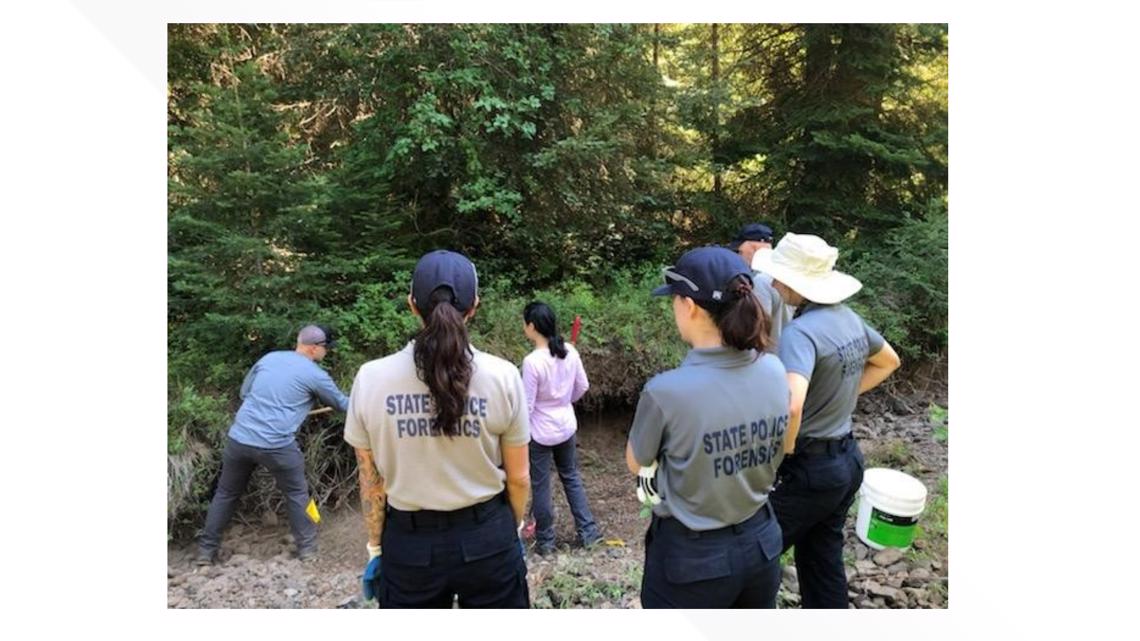
OSP later determined they were going to excavate the areas the cadaver dogs indicated to. On Aug. 16 and 17, the OSP forensic team did just that. However, they found only animal bones.

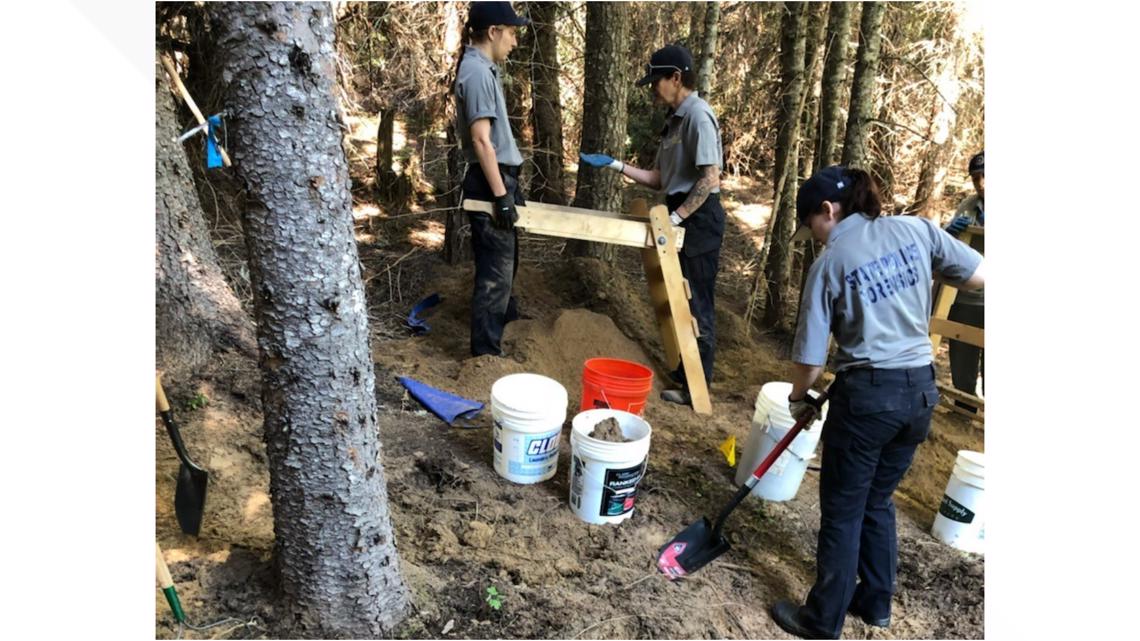
The site
On Friday, Aug. 26, investigative reporter Alexandra Duggan and photojournalist Paul Boehlke followed Timms and Jederberg out to the site where the Finley Creek Jane Doe was discovered 44 years ago.
Timms learned OSP excavated the area that day – she and the task force were not told anything about the excavation they pushed for until she read the results on Facebook.
As she stood near the gravesite of the woman who she believed to be her mother, she wiped away a few tears.
“When I first came here, one of the dogs sat beside me,” Timms said. “She’s trained to find injured humans… she was reading my grief as an injury, and she came back to me again.”
Timms said, while she looked down into the deep hole OSP had created during their excavation, that she was feeling overwhelmed.

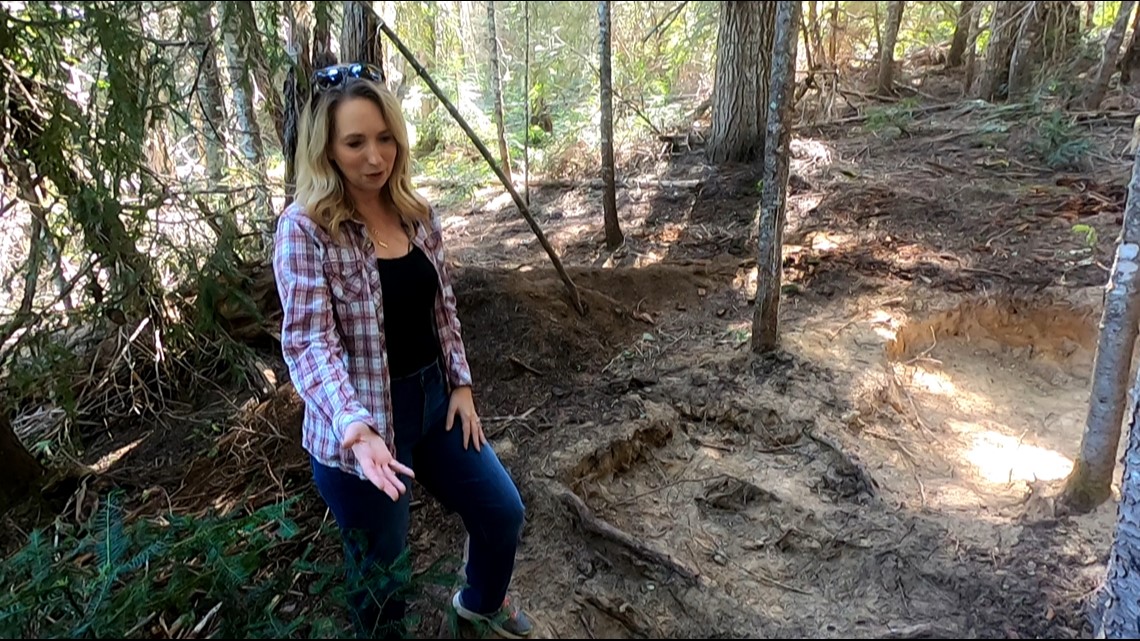
She is extremely grateful that the police and their team had made the trip out to the site to seek answers, even if there was nothing to be found, she said.
However, Timms and Jederberg believe that there could still be remains in the area.
The creek, which is located parallel to the road and a short walking distance from the hillside of the gravesite, showed a small dirt pile beside it, where it looked like OSP had sifted through. In August, the creek is dry of water.
It’s a flood plain, Jederberg said, so bones from the hillside could have shifted, moving downward and getting caught in the water of the creek, possibly embedding into the dirt.
Some of the rocks were visibly skimmed off the top of the creek bed. But, there was no large hole like the gravesite showed.


“It looks like they’ve dug in there. I mean I thought there would be more dirt taken out of here,” Jederberg said. “There was probably some kind of method to this, we just don’t know what it was because (the task force) weren’t here.”
Timms wasn’t disappointed at the excavation of the creek bed, but she expected there would be a much deeper hole from the excavation of that area.
“With erosion and 45 years of earth moving, the bone could be inches and inches below the surface,” Timms said.
In a Facebook post dated Aug. 26, OSP detailed their excavation of the site.
"Forensic Scientists and Detectives conducted excavations at the two points of interest from the cadaver dogs. They also excavated the original burial site. The three locations were examined thoroughly by sifting dirt and material through screens in an attempt to locate even the smallest of bone fragments or other evidence that could be of use in determining an identity through DNA testing. Unfortunately, nothing of evidentiary value was discovered during the operation," it said. "The Oregon State Police and other law enforcement partners will continue to stay in contact with all interested parties in hopes of successfully resolving the identity of the Finley Creek Jane Doe and bringing closure to her family."
Coping with the heartbreaking discovery there are no remains left in the gravesite, Timms said she will keep pushing medical examiners to look at dental records and photos of the Finley Creek Jane Doe and Patty Otto. She needs closure, and there is so little information to provide for it.
“It’s not the same as standing in a graveyard… You have someone who is buried there and the family was able to say their goodbyes,” she said. “This is a place where someone was hidden. She was thrown away by the state. Disposed of. And now, I am fighting three states to get justice for my pregnant mother.”
“I just feel like she’s calling me to bring her home,” Timms said. “And that she’s like… I’ve been trying to help you this whole time. I’m listening.”


Timms has started a GoFundMe for her mother. It can be found here.
KTVB’s award winning investigative team reports on local, crime, and breaking news across Idaho.

